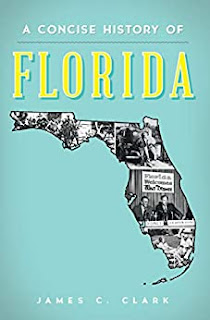A Concise History of Florida by James C. Clark
A joy to read! This well written, excellently edited, and true life American history story covers an amazing phase in the development of a totally unique geographic area.
Peaceful places have no history, something that Florida abounds in.
I loved its depictions that intrigue and clearly bring to life enlightening events in a fascinating informative way.
EXCERPTS:
One sign that the Spanish had come before is seen in the hostile reaction Ponce de León and other explorers received. The Indians had apparently encountered the outsiders before, and the experience was negative.
2,000 BC: First fired-clay pottery comes into use. 500 BC: Mound building takes place along the Crystal River. AD 700: Indian tribes, including the Timucuan, Apalachee, Calusa and Tequesta, are formed.
“Dixie” was heard everywhere. Union troops occupied Pensacola during the war and a regiment of the colorfully dressed New York Zouave soldiers offered a night of entertainment for the community. The show featured soldiers singing songs strong country music roots as evidenced by two of country music’s early stars, Mel Tillis and Slim Whitman. Tillis was born in Dover in 1932, and after a stint in the military, he began writing and then singing songs. In 2012, President Barack Obama awarded Tillis the National Medal of Arts. Whitman was born in Tampa, and his yodeling and high falsetto became an early staple of country music beginning in the 1950s. His hits “Indian Love Call” and “Rose Marie” became country and western classics. Whitman toured with Elvis Presley early in Presley’s career. Presley sang in Florida with two country music tours, one headlined by Hank Snow and the other by Andy Griffith. After he became a star, Presley returned to film Follow That Dream in Ocala and Yankeetown. Singer John Anderson from Apopka had a string of country hits.
RAY CHARLES; Ray Charles had a life filled with great success and great tragedy. He was born in Georgia, but his family moved to Greenville, a small town in the Florida Panhandle. His mother was a sharecropper, and his father worked as a railroad repairman. He played around the shacks where blacks lived in Greenville.
His mother sent him to the Florida School for the Deaf and Blind in St. Augustine. While he was there, his parents died. He learned to play the piano and performed on a local radio station. He came to hate the school and was expelled when he was fifteen years old.
South Florida has given the music a decidedly Latin flavor best exemplified by Cuban-born Gloria Estefan. Her father was a soldier and bodyguard for Cuban dictator Fulgencio Batista. Her family fled to Miami as a result of the revolution that overthrew Batista. She married Emilio Estefan, the leader of the Miami Sound Machine, in 1978. Gloria Estefan became increasingly popular, and eventually the band’s name was changed to Gloria Estefan and the Miami Sound Machine. Down in the Florida Keys, Jimmy Buffett created his own sound that made him a legend.

No comments:
Post a Comment